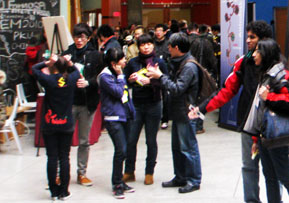Engineering Life
-
-
slice.mit.edu
Filed Under
Recommended
 Professor Patrick Henry Winston ’65, SM ’67, PhD ’70
Professor Patrick Henry Winston ’65, SM ’67, PhD ’70I walked into the Stata Center a few minutes ago. On Sunday, the place is usually on the quiet side, but today I felt as if I had stumbled across the running of the bulls. The place is jammed with something like 1200 undergraduates, with a good number of high-school students, from just about everywhere. Each is eager to show off a new life form and win an international competition.
When I was an undergraduate, I learned about reusable standardized parts, function sharing, and power supplies. That's what these kids are doing, except there isn't any solder. Their standardized parts come from the Registry of Standard Biological parts, and they put them together to create cells with engineered functions.
It's iGem, the International Genetically Engineered Machine competition.
And it all came out of IAP 2003. I was impressed that year by all the yellow stickies covering the walls of the old playroom of the old Artificial Intelligence Laboratory over in Tech Square. Each yellow sticky described something cool you could do if you thought about building a cell the way engineers think about building stuff.
Tom Knight and Randy Rettberg, inspired, had brought together a handful of students to think about synthetic biology, a field they were busy creating. And being engineers, not just scholars, they and their students built some blinker cells—cells with oscillators announcing their presence via fluorescent reporters.
It was so much fun, Knight and Rettberg decided they should invite everybody to do it. Since then, teams have built cells that, for example, smell like wintergreen and fluoresce in the presence of arsenic contaminated water. The first year five teams showed up; this year, 130.
Whoever invented IAP was a genius.






